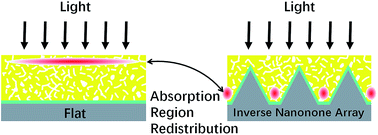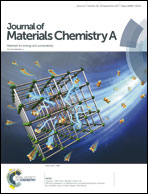Integration of inverse nanocone array based bismuth vanadate photoanodes and bandgap-tunable perovskite solar cells for efficient self-powered solar water splitting†
Abstract
Bismuth vanadate (BiVO4) has been regarded as a promising photoanode material for photoelectrochemical (PEC) water splitting owing to its rich elemental abundance and relatively narrow bandgap. However, the incompatibility of the penetration depth and short diffusion length limits its performance. To overcome this shortcoming, we develop a cost-effective stamping method to fabricate inverse nanocone array (ICA) substrates for supporting nanoporous Mo-doped BiVO4 films. The ICAs show a remarkable light trapping effect in such a way that the intensive light absorption region is advantageously shifted from the top of the active layer on a planar substrate to the bottom surrounded by the ICA, where charge separation is strikingly more efficient. By integrating the ICA-photoanode with a tailor-made, bandgap-adjustable perovskite solar cell, we devised a PEC-photovoltaic (PEC-PV) tandem device, which has achieved a self-powered STH efficiency of around 6.3%. Our study opens a new avenue for designing solar fuel devices with PEC-PV architectures.



 Please wait while we load your content...
Please wait while we load your content...